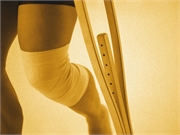- Navigating Your Midlife Crisis: Embracing New Possibilities
- City Raccoons Showing Signs of Domestication
- Mapping the Exposome: Science Broadens Focus to Environmental Disease Triggers
- One Week Less on Social Media Linked to Better Mental Health
- Your Brain Changes in Stages as You Age, Study Finds
- Some Suicide Victims Show No Typical Warning Signs, Study Finds
- ByHeart Formula Faces Lawsuits After Babies Sickened With Botulism
- Switch to Vegan Diet Could Cut Your Greenhouse Gas Emissions in Half
- Regular Bedtime Does Wonders for Blood Pressure
- Dining Alone Could Mean Worse Nutrition for Seniors
Avoiding Pain and Addiction After Sports-Injury Surgery

With opioid addiction soaring in the United States, it should come as good news that an opioid painkiller may not be needed after a sports-injury repair.
A mix of non-addictive medicines may be safer and equally successful in managing pain after shoulder or knee surgery, a study from Henry Ford Hospital in Detroit indicates.
Concerned about the opioid abuse epidemic, doctors there tested a different regimen for pain relief. They treated post-surgical pain with a combination of non-opioid medications, including anti-inflammatories, muscle relaxants and nerve pain relievers.
Nearly half of the study participants required no opioids for pain relief.
“It’s a complete change,” said lead author and orthopedic surgeon Dr. Vasilios Moutzouros. He added that he was taught in medical school “the only mode of pain relief is opioid medication.”
Opioid overdose is the leading cause of accidental death in the United States, and orthopedic surgeons write a substantial number of opioid prescriptions, the authors said in background notes.
The study builds on earlier research showing use of opioids after orthopedic surgery can be reduced, but goes further in suggesting that the drugs may be eliminated.
Changing how pain is treated could keep people from ever being introduced to opioids, Moutzouros said.
The study focused on 141 patients who underwent anterior cruciate ligament (ACL) reconstruction, or repairs for a torn knee meniscus or rotator cuff and shoulder injuries.
All received a combination of five drugs for pain relief before surgery. During surgery, a cocktail of three drugs was injected into surgical sites. Five drugs were given postoperatively, and icing of affected areas was encouraged.
Patients also were prescribed an opioid — 10 oxycodone pills (5 mg) — to be used if pain became too much. But they were asked not to take them, if possible, and to contact the on-call physician for help. One week after surgery, all of the patients said they were satisfied with pain management, and 45% avoided the available oxycodone. One patient required a prescription refill, the study authors noted.
Those who did use the oxycodone (OxyContin) were more likely to report more pain, be female, and have a history of anxiety or depression. Of the four surgeries studied, ACL reconstruction was found to be the most painful, and 30 of the 49 patients who had that surgery used their oxycodone prescription, the researchers said.
Moutzouros said the specific drugs used were less important than employing a range of non-opioid pain relievers. His next goal is to expand the method to all orthopedic surgeries at Henry Ford Hospital.
The approach “definitely makes sense,” said Dr. Joshua Dines, an orthopedic surgeon specializing in sports medicine at the Hospital for Special Surgery in New York City. He was not involved with the study.
Opioids not only pose an addiction risk, he said, but have side effects.
“Patients on opioids, they’re out of it, and constipated,” Dines said.
Doctors following the protocol would have to coordinate several pain relievers after surgery instead of one opioid, Moutzouros said. However, Dines pointed out that patients on opioids may end up also needing stool softeners, laxatives and anti-nausea medicines.
One potential concern was the protocol’s use of ketorolac and other nonsteroidal anti-inflammatory drugs (NSAIDS), which animal studies indicate may inhibit tendon healing, Dines said.
Both Moutzouros and Dines said that patients have turned against extended use of opioids.
“People actually prefer the non-opioid approach,” Moutzouros said, urging patients to discuss pain relief options with their doctor.
Part of managing pain is managing patient expectations, Dines said. There is going to be pain after surgery, especially in the first week or two.
Of the need for opioids after sports surgery, Dines said that “most people can get by with none.”
The study was published recently in Arthroscopy: The Journal of Arthroscopic and Related Surgery.
More information
The U.S. Food and Drug Administration has tips on the safe use of pain medicines.
Source: HealthDay
Copyright © 2025 HealthDay. All rights reserved.










